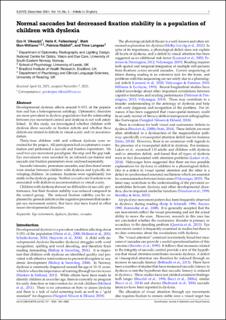| dc.contributor.author | Vikesdal, Gro Horgen | |
| dc.contributor.author | Falkenberg, Helle Kristine | |
| dc.contributor.author | Mon-Williams, Mark | |
| dc.contributor.author | Riddell, Patricia | |
| dc.contributor.author | Langaas, Trine | |
| dc.date.accessioned | 2022-03-16T14:15:14Z | |
| dc.date.available | 2022-03-16T14:15:14Z | |
| dc.date.created | 2022-01-20T11:48:00Z | |
| dc.date.issued | 2021 | |
| dc.identifier.citation | Vikesdal, G. H., Falkenberg, H. K., Mon-Williams, M., Riddell, P., & Langaas, T. (2021). Normal saccades but decreased fixation stability in a population of children with dyslexia. Scandinavian Journal of Optometry and Visual Science, 14(2), 1–7. | en_US |
| dc.identifier.issn | 1891-0882 | |
| dc.identifier.uri | https://hdl.handle.net/11250/2985639 | |
| dc.description.abstract | Developmental dyslexia affects around 5-15% of the population and has a heterogeneous aetiology. Optometric disorders are more prevalent in dyslexic populations but the relationship be- tween eye movement control and dyslexia is not well established. In this study, we investigated whether children with dyslexia show saccadic or fixation deficits and whether these deficits are related to deficits in visual acuity and/or accommodation. Thirty-four children with and without dyslexia were recruited for the project. All participants had an optometric examination and performed a saccade and fixation experiment. We used two eye movement paradigms: the step and the gap task. Eye movements were recorded by an infrared eye-tracker and saccade and fixation parameters were analysed separately. Saccadic latencies, premature saccades, and directional errors were similar between children with dyslexia and typically developing children. In contrast, fixations were significantly less stable in the dyslexic group. Neither saccades nor fixations were associated with deficits in accommodation or visual acuity. Children with dyslexia showed no difficulties in saccadic performance, but their fixation stability was reduced compared to the control group. The reduced fixation stability can be explained by general deficits in the cognitive processes that underpin eye movement control, that have also been found in other neuro-developmental disorders. | en_US |
| dc.language.iso | eng | en_US |
| dc.rights | Navngivelse 4.0 Internasjonal | * |
| dc.rights.uri | http://creativecommons.org/licenses/by/4.0/deed.no | * |
| dc.title | Normal saccades but decreased fixation stability in a population of children with dyslexia | en_US |
| dc.type | Peer reviewed | en_US |
| dc.type | Journal article | en_US |
| dc.description.version | publishedVersion | en_US |
| dc.rights.holder | © Copyright Vikesdal, G. H. et. al. | en_US |
| dc.source.pagenumber | 1-7 | en_US |
| dc.source.volume | 14 | en_US |
| dc.source.journal | Scandinavian Journal of Optometry and Visual Science | en_US |
| dc.source.issue | 2 | en_US |
| dc.identifier.doi | https://doi.org/10.5384/sjovs.v14i2.137 | |
| dc.identifier.cristin | 1985994 | |
| cristin.ispublished | true | |
| cristin.fulltext | original | |
| cristin.qualitycode | 1 | |

